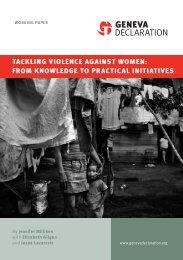Global Burden of Armed Violence - The Geneva Declaration on ...
Global Burden of Armed Violence - The Geneva Declaration on ...
Global Burden of Armed Violence - The Geneva Declaration on ...
You also want an ePaper? Increase the reach of your titles
YUMPU automatically turns print PDFs into web optimized ePapers that Google loves.
Chapter Six<br />
<str<strong>on</strong>g>Armed</str<strong>on</strong>g> <str<strong>on</strong>g>Violence</str<strong>on</strong>g> Against Women<br />
<str<strong>on</strong>g>Armed</str<strong>on</strong>g> violence affects women, men,<br />
girls, and boys in different ways—as both<br />
perpetrators and targets <str<strong>on</strong>g>of</str<strong>on</strong>g> armed violence.<br />
Across cultures, most acts <str<strong>on</strong>g>of</str<strong>on</strong>g> violence are committed<br />
by men, and men and boys also account<br />
for the majority <str<strong>on</strong>g>of</str<strong>on</strong>g> firearm-related deaths and<br />
injuries. In Rio de Janeiro, for example, young<br />
men are 24 times more likely than women to be<br />
killed by armed violence, while men between the<br />
ages <str<strong>on</strong>g>of</str<strong>on</strong>g> 15 and 29 are twice as likely to die from<br />
armed violence as the rest <str<strong>on</strong>g>of</str<strong>on</strong>g> the male populati<strong>on</strong><br />
(Dreyfus et al., 2003; CICS, 2005, p. 14).<br />
<str<strong>on</strong>g>The</str<strong>on</strong>g> present report has focused <strong>on</strong> the main indicators<br />
used to capture and quantify the burden<br />
<str<strong>on</strong>g>of</str<strong>on</strong>g> armed violence and its impact <strong>on</strong> development,<br />
including homicide, direct c<strong>on</strong>flict deaths, indirect<br />
c<strong>on</strong>flict deaths, and ec<strong>on</strong>omic costs. While<br />
these indicators provide valuable informati<strong>on</strong> <strong>on</strong><br />
the burden <str<strong>on</strong>g>of</str<strong>on</strong>g> armed violence at the populati<strong>on</strong><br />
level, they are limited when we turn our attenti<strong>on</strong><br />
to women’s experience <str<strong>on</strong>g>of</str<strong>on</strong>g> armed violence.<br />
Women and girls are affected by armed violence<br />
in different ways, including by direct and indirect<br />
c<strong>on</strong>flict violence, and by lethal and n<strong>on</strong>-lethal<br />
n<strong>on</strong>-c<strong>on</strong>flict violence. <str<strong>on</strong>g>The</str<strong>on</strong>g>y are also more likely<br />
than men and boys to die through intimate partner<br />
violence (IPV). <str<strong>on</strong>g>The</str<strong>on</strong>g> World Health Organizati<strong>on</strong><br />
(WHO) suggests that 40–70 per cent <str<strong>on</strong>g>of</str<strong>on</strong>g> all female<br />
homicides are committed by an intimate partner<br />
(Krug et al., 2002, p. 93).<br />
A number <str<strong>on</strong>g>of</str<strong>on</strong>g> forms <str<strong>on</strong>g>of</str<strong>on</strong>g> gender-based violence specifically<br />
target women and girls because <str<strong>on</strong>g>of</str<strong>on</strong>g> their<br />
sex; this chapter refers to them as ‘violence<br />
against women’. Such violence, including rape,<br />
domestic violence, murder, and sexual abuse, is<br />
a significant cause <str<strong>on</strong>g>of</str<strong>on</strong>g> female mortality and a leading<br />
cause <str<strong>on</strong>g>of</str<strong>on</strong>g> injury for women aged 15 to 44 years<br />
(UNIFEM, 2007). <str<strong>on</strong>g>The</str<strong>on</strong>g> severe impact <str<strong>on</strong>g>of</str<strong>on</strong>g> violence<br />
against women has prompted the United Nati<strong>on</strong>s<br />
Development Fund for Women (UNIFEM) to describe<br />
it as ‘a universal problem <str<strong>on</strong>g>of</str<strong>on</strong>g> epidemic proporti<strong>on</strong>s’<br />
(UNIFEM, n.d.). And violence against women, in<br />
its many forms, is resp<strong>on</strong>sible for ‘more than 100<br />
milli<strong>on</strong> missing women’ due to ill-treatment, lack<br />
<str<strong>on</strong>g>of</str<strong>on</strong>g> access to food and health care, and genderbased<br />
violence such as female infanticide and<br />
sex-selective aborti<strong>on</strong> (Sen, 1990).<br />
This chapter examines some <str<strong>on</strong>g>of</str<strong>on</strong>g> the specific gender<br />
dimensi<strong>on</strong>s <str<strong>on</strong>g>of</str<strong>on</strong>g> the global burden <str<strong>on</strong>g>of</str<strong>on</strong>g> armed violence<br />
and provides an overview <str<strong>on</strong>g>of</str<strong>on</strong>g> forms <str<strong>on</strong>g>of</str<strong>on</strong>g> violence<br />
specifically directed at women. It complements<br />
the examinati<strong>on</strong> <str<strong>on</strong>g>of</str<strong>on</strong>g> gender issues in previous<br />
chapters. Its main findings are:<br />
<str<strong>on</strong>g>The</str<strong>on</strong>g> majority <str<strong>on</strong>g>of</str<strong>on</strong>g> victims <str<strong>on</strong>g>of</str<strong>on</strong>g> IPV are women, and<br />
IPV is the most comm<strong>on</strong> form <str<strong>on</strong>g>of</str<strong>on</strong>g> violence<br />
against women.<br />
A number <str<strong>on</strong>g>of</str<strong>on</strong>g> forms <str<strong>on</strong>g>of</str<strong>on</strong>g> violence specifically<br />
target women and have significant physical,<br />
psychological, social, and ec<strong>on</strong>omic costs.<br />
Data collected <strong>on</strong> violence against women is<br />
sparse and unsystematic; significant investments<br />
in improved data collecti<strong>on</strong> and analysis<br />
should be made.<br />
109<br />
A R M E D V I O L E N C E AG A I N S T WOMEN<br />
1<br />
2<br />
3<br />
4<br />
5<br />
6<br />
7









